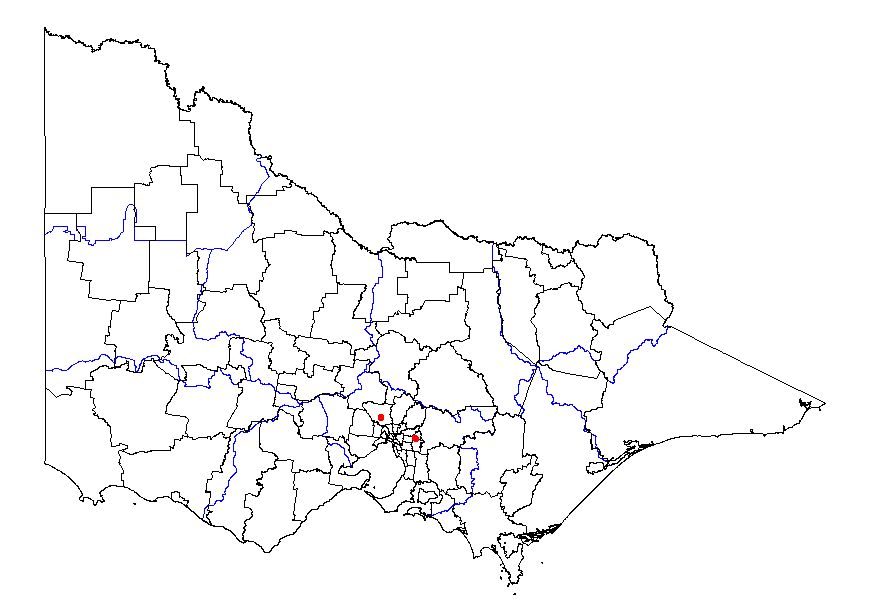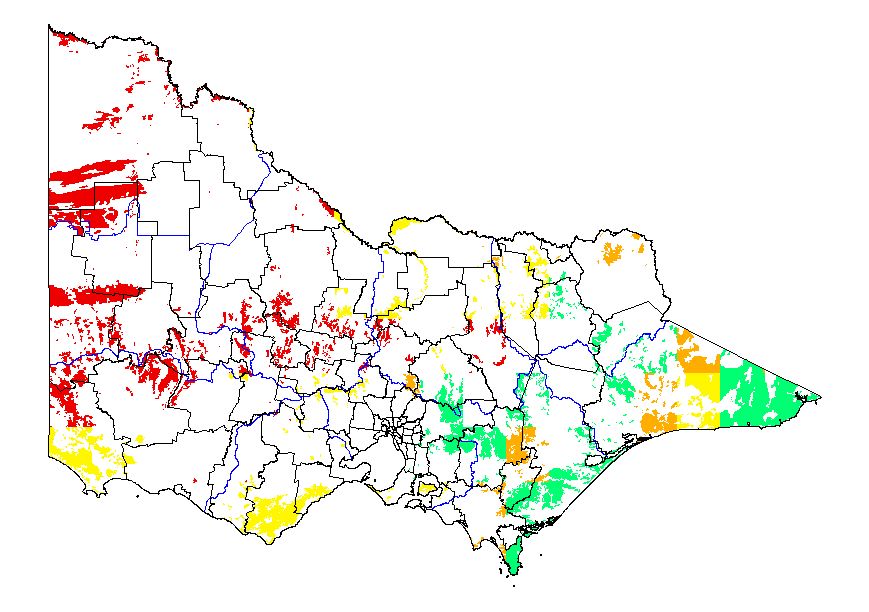Climbing asparagus (Asparagus plumosus)
Present distribution
|  Map showing the present distribution of this weed. | ||||
| Habitat: Native to southern Africa. Subhumid tropical and subtropical forest or open woodland (needs sufficient support for climbing stems). Grows well in areas receiving 500 to 1500 mm rainfall annually (Parsons & Cuthbertson 2002). Occurs extensively in dune systems, heathlands, moist woodlands and rainforests in coastal and near-coastal regions (Muyt 2001). | |||||
Potential distribution
Potential distribution produced from CLIMATE modelling refined by applying suitable landuse and vegetation type overlays with CMA boundaries
| Map Overlays Used Land Use: Forest private plantation; forest public plantation Broad vegetation types Coastal scrubs and grassland; coastal grassy woodland; heathy woodland; lowland forest; heath; swamp scrub; box ironbark forest; inland slopes woodland; sedge-rich woodland; moist foothills forest; plains grassy woodland; valley grassy forest; herb-rich woodland; riverine grassy woodland; riparian forest; rain shadow woodland; mallee heath; mallee woodland; Wimmera/mallee woodland. Colours indicate possibility of Asparagus plumosus infesting these areas. In the non-coloured areas the plant is unlikely to establish as the climate, soil or landuse is not presently suitable. | 
|
Impact
QUESTION | COMMENTS | RATING | CONFIDENCE |
| Social | |||
| 1. Restrict human access? | Climb to 3 – 5 m. Capable of dominating the ground layer and lower canopy, forming vigorous dense mats (Muyt 2001). Branching, occasionally spiny (Parsons & Cuthbertson 2002). Plant may impede individual access. | ml | mh |
| 2. Reduce tourism? | ‘.. it climbs individual trees and may eventually smother them’ .. 'branching, occasionally spiny’ (Parsons & Cuthbertson 2002). Plant may have minor effect on aesthetics and recreational uses. | ml | mh |
| 3. Injurious to people? | Occasionally spiny (Parsons & Cuthbertson 2002). Spines at most times of year. | mh | mh |
| 4. Damage to cultural sites? | ‘.. it climbs individual trees and may eventually smother them’ (Parsons & Cuthbertson 2002). Plant may have moderate visual effect if occurs at cultural site. | ml | mh |
| Abiotic | |||
| 5. Impact flow? | Terrestrial species (Parsons & Cuthbertson 2002). | l | mh |
| 6. Impact water quality? | Terrestrial species (Parsons & Cuthbertson 2002). | l | mh |
| 7. Increase soil erosion? | ‘Long slender fibrous rhizomes subtending a mass of fibrous non-tuberous roots’ (Parsons & Cuthbertson 2002). Plant may help to bind soil. Low probability of large-scale soil movement. | l | mh |
| 8. Reduce biomass? | Capable of dominating the ground layer and lower canopy, forming vigorous dense mats that smother herbaceous plants and smaller shrubs (Muyt 2001). Direct replacement of biomass by invader. | ml | mh |
| 9. Change fire regime? | Weed effect on fire regime not documented. Likely to have only negligible effect on fire risk. | l | l |
| Community Habitat | |||
| 10. Impact on composition (a) high value EVC | EVC=Low rises woodland (BCS=E); CMA=Wimmera; Bioreg=Lowan Mallee; CLIMATE =VH. Once established ‘it quickly climbs over understorey shrubs into the forest canopy .. in the more open forest situations .. it climbs individual trees and may eventually smother them’ (Parsons & Cuthbertson 2002). Major effect on lower and middle strata. May also have an effect on upper strata. | mh | mh |
| (b) medium value EVC | EVC=Riverine chenopod woodland (BCS=D); CMA=Mallee; Bioreg=Lowan Mallee; CLIMATE =VH. Capable of dominating the ground layer and lower canopy, forming vigorous dense mats that smother herbaceous plants and smaller shrubs (Muyt 2001). Major effect on lower and middle strata. May also have an effect on upper strata. | mh | mh |
| (c) low value EVC | EVC=Lowland forest (BCS=LC); CMA=Glenelg Hopkins; Bioreg=Glenelg Plain; CLIMATE =VH. Once established ‘it quickly climbs over understorey shrubs into the forest canopy .. in the more open forest situations .. it climbs individual trees and may eventually smother them’ (Parsons & Cuthbertson 2002). Major effect on lower and middle strata. May also have an effect on upper strata. | mh | mh |
| 11. Impact on structure? | Once established ‘it quickly climbs over understorey shrubs into the forest canopy .. in the more open forest situations .. it climbs individual trees and may eventually smother them’ (Parsons & Cuthbertson 2002). Capable of dominating the ground layer and lower canopy, forming vigorous dense mats that smother herbaceous plants and smaller shrubs (Muyt 2001). Major effect on lower and middle strata. | mh | mh |
| 12. Effect on threatened flora? | Weed not documented as posing an additional threat to threatened flora. | mh | l |
| Fauna | |||
| 13. Effect on threatened fauna? | Weed not documented as posing an additional threat to threatened fauna. | mh | l |
| 14. Effect on non-threatened fauna? | Capable of dominating the ground layer and lower canopy, forming vigorous dense mats that smother herbaceous plants and smaller shrubs (Muyt 2001). Not specifically documented although it is possible that weed reduces habitat and food of non-threatened fauna species. | ml | mh |
| 15. Benefits fauna? | Weed not documented as providing support to desirable species. | h | mh |
| 16. Injurious to fauna? | Weed is spiny (Parsons & Cuthbertson 2002). Not documented to be injurious to animals although plant has spines throughout the year. | mh | mh |
| Pest Animal | |||
| 17. Food source to pests? | Not documented as a food source to pest species. | l | mh |
| 18. Provides harbour? | Weed not known to provide harbour to pest species. | l | mh |
| Agriculture | |||
| 19. Impact yield? | Not a weed of agriculture. | l | mh |
| 20. Impact quality? | Not a weed of agriculture. | l | mh |
| 21. Affect land value? | Weed not known to affect land value. | l | mh |
| 22. Change land use? | Weed not known to cause a change in priority of land use. | l | mh |
| 23. Increase harvest costs? | Not a weed of agriculture. | l | mh |
| 24. Disease host/vector? | Cercospora asparagi is a specialised pathogenic fungus causing Cercospora blight on asparagus which is a significant pest of crops (PIER 2005). Host to major pest of important agricultural produce. | h | mh |
Invasive
QUESTION | COMMENTS | RATING | CONFIDENCE |
| Establishment | |||
| 1. Germination requirements? | Most seed germination occurs in spring but may occur at other times provided sufficient moisture is available (Muyt 2001). Opportunistic germinator. | h | mh |
| 2. Establishment requirements? | Needs shelter and support for maximum growth (Parsons & Cuthbertson 2002). Requires more specific requirements to establish. | ml | mh |
| 3. How much disturbance is required? | Can invade undisturbed native bushland (Parsons & Cuthbertson 2002). Establishes in undisturbed natural ecosystems. | h | mh |
| Growth/Competitive | |||
| 4. Life form? | Climbing woody perennial (Parsons & Cuthbertson 2002). Life form – climber. | ml | mh |
| 5. Allelopathic properties? | None described. | l | mh |
| 6. Tolerates herb pressure? | In Florida, the two-spotted mite (Tetranychus telarius L.) feed on the plants and cause them to brown (Wilson 1931). Weed may still persist. | ml | mh |
| 7. Normal growth rate? | ‘Seedling develop rapidly’ (Parsons & Cuthbertson 2002). Moderately rapid growth that will equal competitive species of same life form. | mh | mh |
| 8. Stress tolerance to frost, drought, w/logg, sal. etc? | Susceptible to frost and drought. Susceptible to waterlogging (EFP 1996). Has rhizomes so maybe tolerant of fire. Insufficient information to determine tolerance to salinity but seems that plant grows best in fertile soils. | l | m |
| Reproduction | |||
| 9. Reproductive system | Reproduces by seed and rhizome (Parsons & Cuthbertson 2002). Vegetative and sexual reproduction. | h | mh |
| 10. Number of propagules produced? | Plant reproduces by both seed and rhizomes but insufficient information to determine number of propagules produced per flowering event. | m | l |
| 11. Propagule longevity? | Insufficient information to determine propagule longevity. | m | l |
| 12. Reproductive period? | Capable of dominating the ground layer and lower canopy, forming vigorous dense mats that smother herbaceous plants and smaller shrubs (Muyt 2001). No information to determine whether plant forms self-sustaining monocultures but is a perennial plant which reaches sexual maturity in its second year so would produce viable propagules for greater than 3 years. | mh | m |
| 13. Time to reproductive maturity? | ‘usually reach sexual maturity in their second year’ (Muyt 2001). 1 – 2 years after germination. | mh | h |
| Dispersal | |||
| 14. Number of mechanisms? | Dispersed primarily by birds but also by water and in garden refuse (Muyt 2001). Bird dispersed seeds. | h | mh |
| 15. How far do they disperse? | Dispersed primarily by birds but also by water and in garden refuse (Muyt 2001). Some propagules will disperse greater than 1 km but many will reach 200 – 1000 m. | mh | h |
References
Australian National Herbarium (ANH) 2006, Australia’s Virtual Herbarium, Australian National Herbarium, Centre for Plant Diversity and Research, viewed 23 Aug 2006 , http://www.anbg.gov.au/avh/
Encyclopaedia of Flowers and Plants (EFP) 1996, Asparagus, Botany.com, viewed 30 Aug 2006, http://www.botany.com/asparagus.html
Global Biodiversity Information Facility (GBIF) 2006, Global biodiversity information facility: Prototype data portal, viewed 23 Aug 2006, http://www.gbif.org/
Missouri Botanical Gardens (MBG) 2006, w3TROPICOS, Missouri Botanical Gardens Database, viewed 23 Aug 2006, http://mobot.mobot.org/W3T/Search/vast.html
Muyt 2001, A. 2001, Bush invaders of south-east Australia: a guide to the identification and control of environmental weeds in south-east Australia, R.G. and F.J. Richardson, Collingwood.
Pacific Island Ecosystem at Risk (PIER) 2005, Risk assessment: Asparagus setaceous , Hawaii Ecosystem at Risk, viewed 12 Sep 2006 , http://www.hear.org/Pier/wra/pacific/
Parsons, W.T. & Cuthbertson, E.G. 2002, Noxious weeds of Australia, 2nd ed., CSIRO Publishing, Collingwood.
Wilson, J.W. 1931, ‘The two-spotted mite (Tetranychus telarius L.) on Asparagus plumosus’, Bulletin, Florida Agriculture, June, no. 234, p. 20, CAB Abstracts.
Global present distribution data references
Agnew, A.D. 1974, Upland Kenya wildflowers – a flora of the ferns and herbaceous flowering plants of upland Kenya, Oxford University Press, Glasgow
Arnold, T.H. & DeWet, B.C. (eds) 1993, Plants of Southern Africa – names and distributions, National Botanical Institute, Pretoria.
Australian National Herbarium (ANH) 2006, Australia’s Virtual Herbarium, Australian National Herbarium, Centre for Plant Diversity and Research, viewed 23 aug 2006 , http://www.anbg.gov.au/avh/
Global Biodiversity Information Facility (GBIF) 2006, Global biodiversity information facility: Prototype data portal, viewed 23 Aug 2006, http://www.gbif.org/
Missouri Botanical Gardens (MBG) 2006, w3TROPICOS, Missouri Botanical Gardens Database, viewed 23 Aug 2006, http://mobot.mobot.org/W3T/Search/vast.html
Feedback
Do you have additional information about this plant that will improve the quality of the assessment?
If so, we would value your contribution. Click on the link to go to the feedback form.


